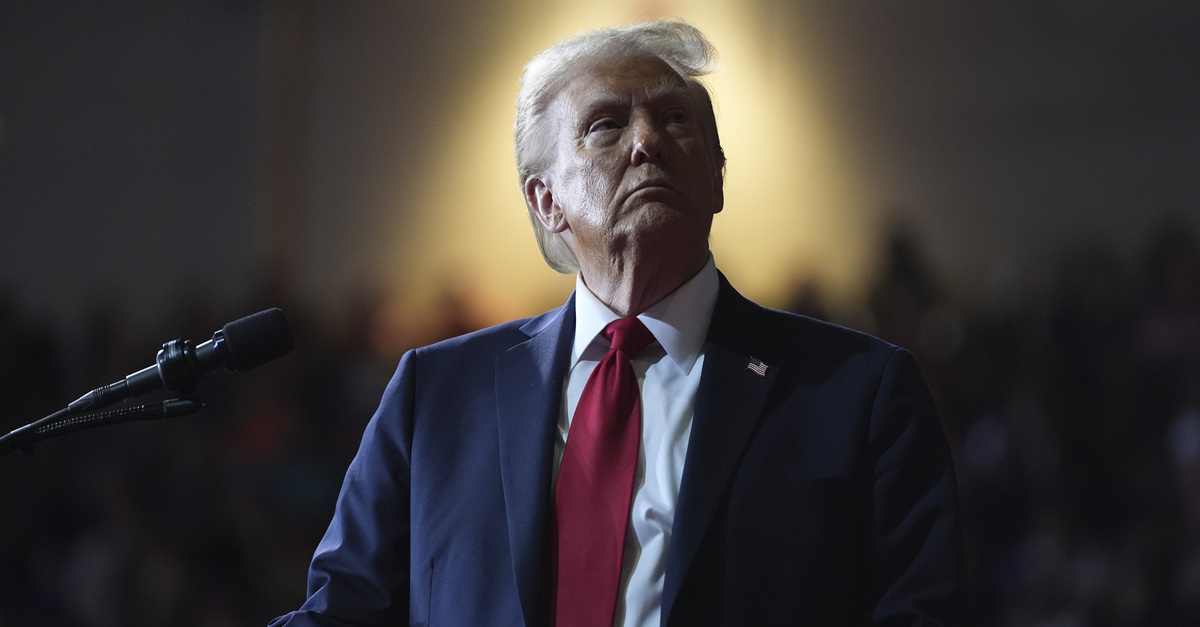
FILE – Republican presidential nominee former President Donald Trump watches a video screen at a campaign rally at the Salem Civic Center, in Salem, Va, Nov. 2, 2024 (AP Photo/Evan Vucci, File).
The Trump administration is calling on the U.S. Supreme Court to scrap a ruling made by a federal judge this month in its probationary mass firings case involving the Office of Personnel and Management and acting OPM director Charles Ezell after the president’s Justice Department lawyers were swatted down by an appeals court last week.
“The district judge in this case spontaneously issued a preliminary injunction ordering a half-dozen departments and agencies to immediately offer reinstatement to over 16,000 probationary employees who had been lawfully terminated,” the Justice Department says in its Supreme Court application to stay an injunction handed down by U.S. District Judge William Alsup on March 15. “This Court should not allow a single district court to erase Congress’s handiwork and seize control over reviewing federal personnel decisions,” the DOJ’s application says. “Much less to do so by vastly exceeding the limits on the scope of its equitable authority and ordering reinstatements en masse.”
The OPM and Ezell, who was appointed by Trump after he took office in January, are being sued for firing federal workers while they were still in the probationary period of their employment. Alsup tore into the Trump administration for the mass terminations at a hearing on March 13, calling it a “sad day” when the government would get rid of “good” workers — supposedly on the basis of performance — knowing “good and well that’s a lie,” the judge said as he ordered agencies to “immediately” rehire those who have been booted.
DOJ lawyers filed an emergency motion to stay Alsup’s order in district court and one in California’s Ninth Circuit on March 14, saying the claims of injury by the plaintiffs are “far too speculative to support standing to maintain this lawsuit,” among other complaints about the arguments made by the five labor unions and five nonprofit organizations suing Ezell and OPM. Alsup ruled against the stay on March 15, while the appeals court responded Monday with its denial.
“Given that the district court found that the employees were wrongfully terminated and ordered an immediate return to the status quo ante, an administrative stay of the district court’s order would not preserve the status quo,” wrote U.S. Circuit Judges Judges Barry Silverman and Ana de Alba in their 2-1 ruling denying Trump’s DOJ and its emergency motion.
“It would do just the opposite — it would disrupt the status quo and turn it on its head,” the judges said.
In its application to the Supreme Court, the Trump administration argues that one of the biggest reasons for staying Alsup’s order is that the district court delivered it in a suit filed “not by the employees themselves (whose claims Congress has channeled through special administrative procedures), but by a group of nonprofits who claimed that these layoffs could contribute to downstream harms from less-robust governmental services,” the DOJ says.
“The court’s preliminary injunction thus let third parties hijack the employment relationship between the federal government and its workforce,” the application alleges. “And, like many other recent orders, the court’s extraordinary reinstatement order violates the separation of powers, arrogating to a single district court the Executive Branch’s powers of personnel management on the flimsiest of grounds and the hastiest of timelines. That is no way to run a government.”
More from Law&Crime: ‘Commander Reyes’: Trump defense secretary mocks judge who ruled against transgender ban, says she should train Green Berets since she’s ‘now a top military planner’
According to DOJ lawyers, the plaintiffs and respondents whose claims formed the basis for the injunction are barely connected to anyone who has been fired. They say that Congress has created “an entirely different framework” for resolving legal challenges to the terminations of federal employees — under the “reticulated process” set out in the Civil Service Reform Act of 1978 — and ultimately believe nonprofits shouldn’t get involved when they have “at best, only distant connections” to the people being fired.
“Declaring open season on challenges to federal personnel management is especially unsound,” the DOJ’s application says. “Allowing strangers to the federal-employment relationship to head straight to district court and raise claims that the affected federal employees themselves cannot raise would upend that entire process.”
The DOJ added, “This Court should stop the ongoing assault on the constitutional structure before further damage is wrought.”
Before filing their motions to stay in appeals and district court, DOJ lawyers rounded up and attached declarations provided by officials from the Departments of Agriculture, Defense, Energy, the Interior, the Treasury, and Veterans Affairs, which they claimed exercised the belief that Alsup’s order “constitutes an extraordinary intrusion into the authority of the Executive Branch and its agencies” by “requiring six agencies to reinstate previously terminated probationary employees” and “precluding the Office of Personnel Management from giving further guidance to agencies on personnel matters,” according to the district court motion.
Ninth U.S. Circuit Judge Bridget Bade — a Trump appointee who disagreed with Silverman, a Clinton appointee, and de Alba, a Biden appointee, in a 10-page dissent — explained last week that she would have granted an emergency temporary stay due to the government “persuasively” arguing that the district court’s preliminary injunction order “imposes a substantial administrative burden,” per her dissent. Bade said that the six agencies identified in the preliminary injunction have already “completed the challenged terminations” and Alsup’s order would “change that status quo” by requiring those agencies to “immediately offer reinstatement” to any and all probationary employees terminated on or around Feb. 13 and 14. Trump’s DOJ props up this point in its application to the Supreme Court.
More from Law&Crime: ‘Irreparable injuries flowing’: Judge slams Trump DOJ for refusing to ‘make any further effort to get at the truth’ in probationary firings case, denies motion for stay
“The district court has compelled the government to embark on the massive administrative undertaking of reinstating, and onboarding to full duty status, thousands of terminated employees in the span of a few days,” the department says. “Exacerbating the burden, the district court has insisted that employees must be returned to full duty status and staffed so as to restore the services that respondents seek to use. And the government is required to reinstate employees to active-duty status and provide them with assignments, all subject to the ongoing supervision of the district court. The injunction appears to prevent the agencies from terminating those employees based on the agencies’ independent judgment or even on newly arising grounds, at least absent clarification or permission from the district court. The ensuing financial costs and logistical burdens of ongoing compliance efforts are immense.”
Ezell and OPM have maintained that they simply told agencies to review their probationary workers and make determinations about whether to continue their employment based on need and did not order the firings themselves. Alsup asked the DOJ to put Ezell forward for testimony earlier this month to help prove that claim, but the Trump administration repeatedly refused.
“The meaning of the order is plain,” Alsup concluded in her March 15 ruling. “OPM cannot direct another agency to fire an employee simply by dressing up the directive as guidance. The undersigned has not and cannot circumscribe OPM’s lawful performance of statutorily authorized functions, including issuing guidance that goes no further.”
Love true crime? Sign up for our newsletter, The Law&Crime Docket, to get the latest real-life crime stories delivered right to your inbox.








